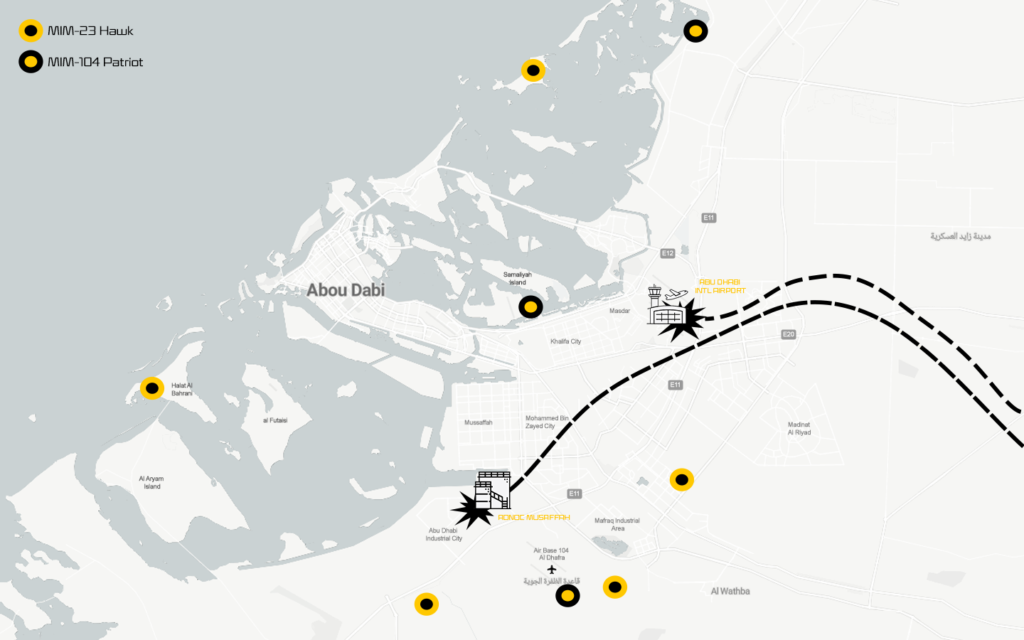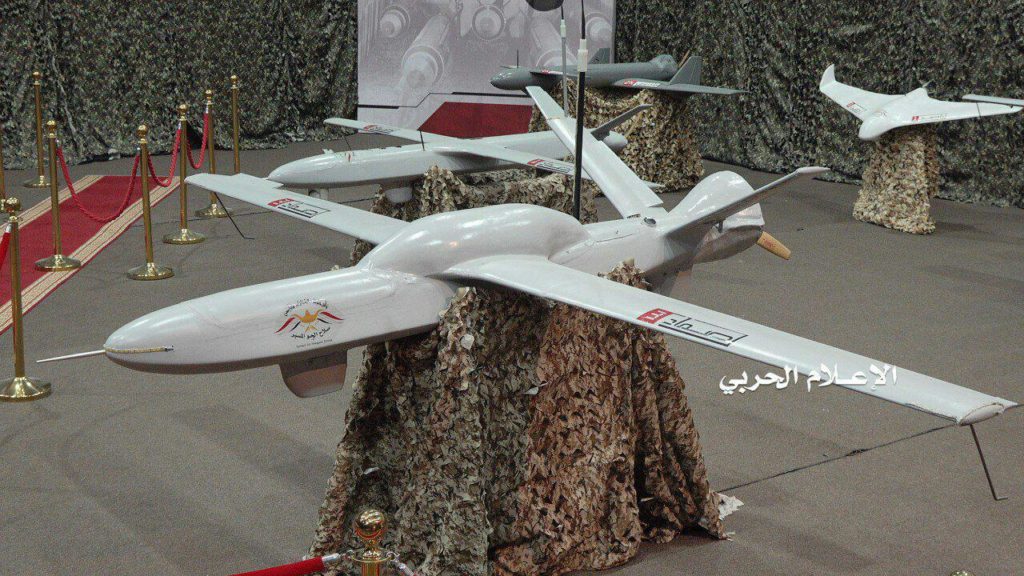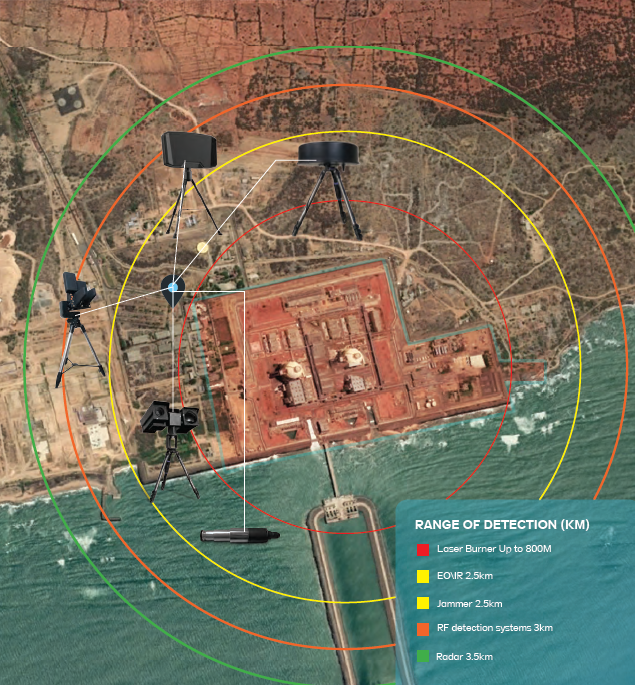What lessons to learn from the houthi drone attacks on Abu Dhabi?
On January 17, 2022, for the first time, the UAE was hit by the strike of two suicide drones launched by Houthi rebels from Yemen. Ballistic missiles were also mentioned, one of which was allegedly intercepted by a THAAD anti-missile battery; but this information is unsure due to the lack of evidence. The types of drones used are probably of the Samad-3, to our understanding the only ones in the Houthis’ arsenal having sufficient autonomy to cover the more than 1000 km separating the territories of Yemen and Abu Dhabi.
One of the two drones hit a truck at Abu Dhabi International Airport, the second hit the ADNOC’s oil depot south of Mussafah and the fire spread to three tank trucks, killing three and injuring six.
This unprecedented attack raises two questions:
- Abu Dhabi is protected by 8 air defense sites around the city and the ground to air defense sound inactivated. Were the drones detected by radar during their route?
- The UAE announced the additional order of anti-drone systems from the Israeli company SKYLOCK? Therefore is this equipment really meet the threat posed by an attack like this?
The ground-to-air defense in Abu Dhabi
There are 8 ground/air defense sites surrounding the city, five MIM-23 HAWK batteries and three MIM-104 PATRIOT system batteries. These systems were not designed to destroy small targets at very low altitudes. They can, however, succeed, at a relatively short range, but on the condition that the associated radars are able to detect and follow the targets, which is far from obvious in an urban environment as dense as that of the administrative capital of the United Arab Emirates.
The first drone hit the international airport (AUH) located northeast of the city. The nearest ground-to-air defense site, a MIM-104 PATRIOT battery, is 12 km west of the airport; the drone could therefore approach the airport from the east at low altitude (as the videos suggest looping on social feeds) by escaping the radar detection.
The second drone hit an oil site located exactly 15 km south of the same ground/air site as before and 9.6 km north of a MIM-23 Hawk battery. Was it intentional to choose strategic sites as far away as possible from ground/air sites or was it a coincidence?

It is impossible to know the level of preparation that the Houthis brought to carry out this attack, but the targets hit are located in particularly unfavorable places for the Emirati ground/air defense.
Samad-3 drones or cruise missiles?
The Samad-3 drones are drones with a wingspan of 4.5 m and 2.8 m long, with a range of 1,600 km and which could carry 40 kg of payload. This model is powered by a 2-stroke twin-cylinder engine from model making (3W-110i B2 of German origin), coupled with a propeller allowing it to fly up to 8,000 m in altitude at a speed of 200 to 250 km/ h. The overall design and flight control electronics are directly derived from model aircraft. If the construction of the Samad-3 is closer to model making and the drone, the performances are much closer to the cruise missile.
Very little information is available on the guidance system of the drone. The most likely is that the navigation is inertial, readjusted by satellite (GPS, GLONASS, GALILEO…), but the presence on the top of a large antenna suggests that the drone can be remotely operated. However, given the autonomy of these UAVs, it is very unlikely that they will be longer than about a hundred kilometers. Nevertheless, it would be technically possible that an operator located near the destination manually pilot the drone towards its target. This is not the most plausible option because the drone does not seem to be equipped with an optronic system allowing the operator to pilot with precision, but this option cannot be completely eliminated.

Editor’s note: the “bump” on the top of the fuselage is probably an additional tank to increase autonomy.
Is SKYLOCK CUAS suitable?
The anti-drone system provided by the Israeli company consists, for detection, of a radar operating in the 3 GHz frequency range, a radio frequency interception system giving the direction of arrival of the signals and an optronic system responsible for target tracking and identification.
- The radar is made up of 3×360° panels, each panel providing 120°. The maximum detection range would be 5 km, probably more on a target like the relatively large Samad-3.
- Radio frequency detection would have a maximum range of 4 km, but only 1.5 km in a noisy environment such as an urban environment.
- The electro-optical system would have the ability to track a drone up to 4 km away.
- Neutralization is ensured by an active jamming system on the WiFi frequency bands (2.4 and 5.8 GHz), GSM and GPS frequencies. The effective range of the jamming would reach 2.5 km. The company also showcases an interceptor drone which comes in the form of a quadcopter with a maximum range of 4 km.
The radar is able to detect drones like the Samad-3 without any doubt. Given its size, is not very discreet and can be spotted by many radars. The problem is to be able to detect sufficiently early, in order to have a significant reaction warning (the target travels ± 60 m/s), a drone flying barely above the buildings; it is more the positioning of the radar than the model used that will make the difference.

On the other hand, radio frequency detection is likely to be completely ineffective against this type of drone which is used like a cruise missile with a firing on geographic coordinates without being remotely operated.
The proposed neutralization means, jamming and drone interceptor, also seem quite unsuitable for this type of threat.
The drone most likely does not use a radio link, so jamming will have no effect on it. Only the jamming of the GPS signals could cause relative discomfort by degrading its accuracy but, given the effective range of the jamming, it is unlikely that the drift generated will be sufficient for the Samad-3 to magnify its target. And again, this assumption is only valid if the target is within the range of the jammer because, once out of the jamming zone, the drone will immediately correct its route.
As for the solution of the quadcopter interceptor, we have serious doubts about the ability to intercept a drone moving between 200 and 250 km/h.
In Conclusion
The juxtaposition of systems released by SKYLOCK is a standard solution; it can be effective against modified civilian drones but not really suitable for this type of threat which is more akin to cruise missiles.
Perhaps the crucial lesson to be learned is that the Houthis seem to prepare carefully their attacks, taking care to circumvent existing defenses as much as possible. It could also be luck. But such type of preparatory tasks are quite easy while browsing on the Internet. Strengthening and professionalization are new assets for non-state armed movements. This is something to consider as it doesn’t look like a blind attack and the low damage is due to the low warhead and not a lack of tactics or targeting.
The word “drone” covers a very wide range of UAVs and an anti-drone solution is not necessarily suitable (it is even rare) for all types of drones. The United Arab Emirates were attacked by two cruise missiles “handcrafted”. Developed from radio model parts easily found on recreational drones websites or remote-controlled planes on-line shops. However, even though their price is very low, these artefacts must be treated as “missiles” and the counter-measures must be adapted.
Such mission is traditionally assigned to short-range ground/air defence and rarely to systems C-UAV (counter-unmanned aerial vehicles). With asymmetrical threats, the response of ground/air systems is economically unsustainable over time (so as volume) because of the price of these systems and their ammunition. Also, the eagerness to announce the order of additional SKYLOCK anti-drone systems is more a matter of communication aimed at the public than a real desire to address these attacks.
In the short term, the best asset of the UAE to counter such attacks in the future rely on the PANTSIR (50 systems have been acquired by the UAE; minus a handful lost in Libya). Moreover, the UAE is still seeking to acquire the Israeli anti-aircraft system “Iron Dome”, or even the Barak-8 in parallel with the recent order for the South Korean system Cheongung II (KM-SAM2). The Cheongung II is co-developed with Russia based on the S-350 and S-400 and is conceived to replace the MIM-23 HAWK. For its part, Russia offers the UAE its TOR-M2KM to protect its sensitive sites worldwide. All of these systems are much better suited to address this type of threat than the ground-to-air systems deployed today or the multi-layer solution promoted by SKYLOCK.

